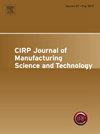Investigation of the combined effect of friction and interstand tension on the operative conditions of a two-stands reversing cold mill
IF 5.4
2区 工程技术
Q2 ENGINEERING, MANUFACTURING
CIRP Journal of Manufacturing Science and Technology
Pub Date : 2025-04-09
DOI:10.1016/j.cirpj.2025.03.009
引用次数: 0
Abstract
Cold rolling is one of the fundamental processes for the manufacturing of steel plates and sheets intended for several applications. The quality of the rolled strips, among other factors, is strictly related to the friction conditions within the roll bite, initially unknown. The present paper proposes an accurate approach to inversely calibrate the coefficient of friction (CoF) at the roll/strip interface in a two-stands reversing cold mill (RCM) by combining numerical simulation, training of accurate regression model and a final optimization step managed by a multi-objective genetic algorithm. The process was reproduced in the virtual environment of the commercial code Abaqus by modelling both the blank and the rolls as deformable bodies. A set of simulations, arranged according to a full factorial plan, were run by changing the CoF of the first (µ1) and second stand (µ2). The discrepancy between numerical results (rolling forces and interstand tension) and the correspondent data acquired from the in-situ measurements allowed to train accurate regression models, subsequently used in an optimization managed by the MOGA-II genetic algorithm. The methodology was applied to evaluate the tribological performance of two lubricants, a natural based (GR) and a semi-synthetic (SS) one. The numerical simulations of the process highlighted a cross interaction between the rolling conditions of the two stands: in fact, the increase of the CoF in the first stand affects the interstand tension that, in turns, influences the distribution of the contact pressure in the roll bite of the second stand. Therefore, a precise calibration of the friction coefficients was possible only by looking simultaneously at the rolling forces and at the interstand tension. It was eventually demonstrated that GR lubricant showed comparable tribological performance to the SS one but with a non-negligible reduction on the rolling forces and a sensibly lower impact from the environmental perspective.
摩擦和机架间张力对双机架可逆冷轧机运行条件的综合影响研究
冷轧是制造用于多种用途的钢板和薄板的基本工艺之一。轧制带钢的质量,除其他因素外,与辊咬合力内的摩擦条件密切相关,最初未知。本文提出了一种结合数值模拟、精确回归模型训练和多目标遗传算法管理的最终优化步骤的双机架可逆冷轧机辊带界面摩擦系数反校正的精确方法。这个过程是在商业代码Abaqus的虚拟环境中通过将毛坯和轧辊建模为可变形体来复制的。通过改变第一站(µ1)和第二站(µ2)的CoF,按照全阶乘计划进行了一组模拟。数值结果(轧制力和机架间张力)与从现场测量中获得的相应数据之间的差异允许训练精确的回归模型,随后用于由MOGA-II遗传算法管理的优化。应用该方法对天然基(GR)和半合成(SS)两种润滑油的摩擦学性能进行了评价。该过程的数值模拟突出了两个机架轧制条件之间的交叉相互作用:事实上,第一机架CoF的增加会影响机架间张力,进而影响第二机架轧辊咬合处的接触压力分布。因此,只有同时观察滚动力和机架间张力,才能精确校准摩擦系数。最终证明,GR润滑油具有与SS润滑油相当的摩擦学性能,但对滚动力的降低不可忽略,并且从环境角度来看影响明显降低。
本文章由计算机程序翻译,如有差异,请以英文原文为准。
求助全文
约1分钟内获得全文
求助全文
来源期刊

CIRP Journal of Manufacturing Science and Technology
Engineering-Industrial and Manufacturing Engineering
CiteScore
9.10
自引率
6.20%
发文量
166
审稿时长
63 days
期刊介绍:
The CIRP Journal of Manufacturing Science and Technology (CIRP-JMST) publishes fundamental papers on manufacturing processes, production equipment and automation, product design, manufacturing systems and production organisations up to the level of the production networks, including all the related technical, human and economic factors. Preference is given to contributions describing research results whose feasibility has been demonstrated either in a laboratory or in the industrial praxis. Case studies and review papers on specific issues in manufacturing science and technology are equally encouraged.
 求助内容:
求助内容: 应助结果提醒方式:
应助结果提醒方式:


